A Detailed Analysis of Social Innovation & Community Engagement
VerifiedAdded on 2023/06/05
|11
|2645
|400
Essay
AI Summary
This essay delves into the concepts of social innovation and community engagement, highlighting their interconnectedness and importance in addressing societal challenges. It discusses social entrepreneurship as a key driver of social innovation, focusing on its role in creating social value and addressing social, cultural, and environmental issues. The essay includes a SWOT analysis to determine the strengths, weaknesses, opportunities, and threats of social entrepreneurship, as well as a PESTLE analysis to examine the political, economic, social, technological, legal, and environmental factors influencing it. Ethical and funding implications are also addressed, emphasizing the importance of adhering to ethical standards in social work. Finally, the essay identifies challenges for implementing social entrepreneurship, such as managing cash flow, hiring employees, time management, and identifying social needs, providing a comprehensive overview of the topic.
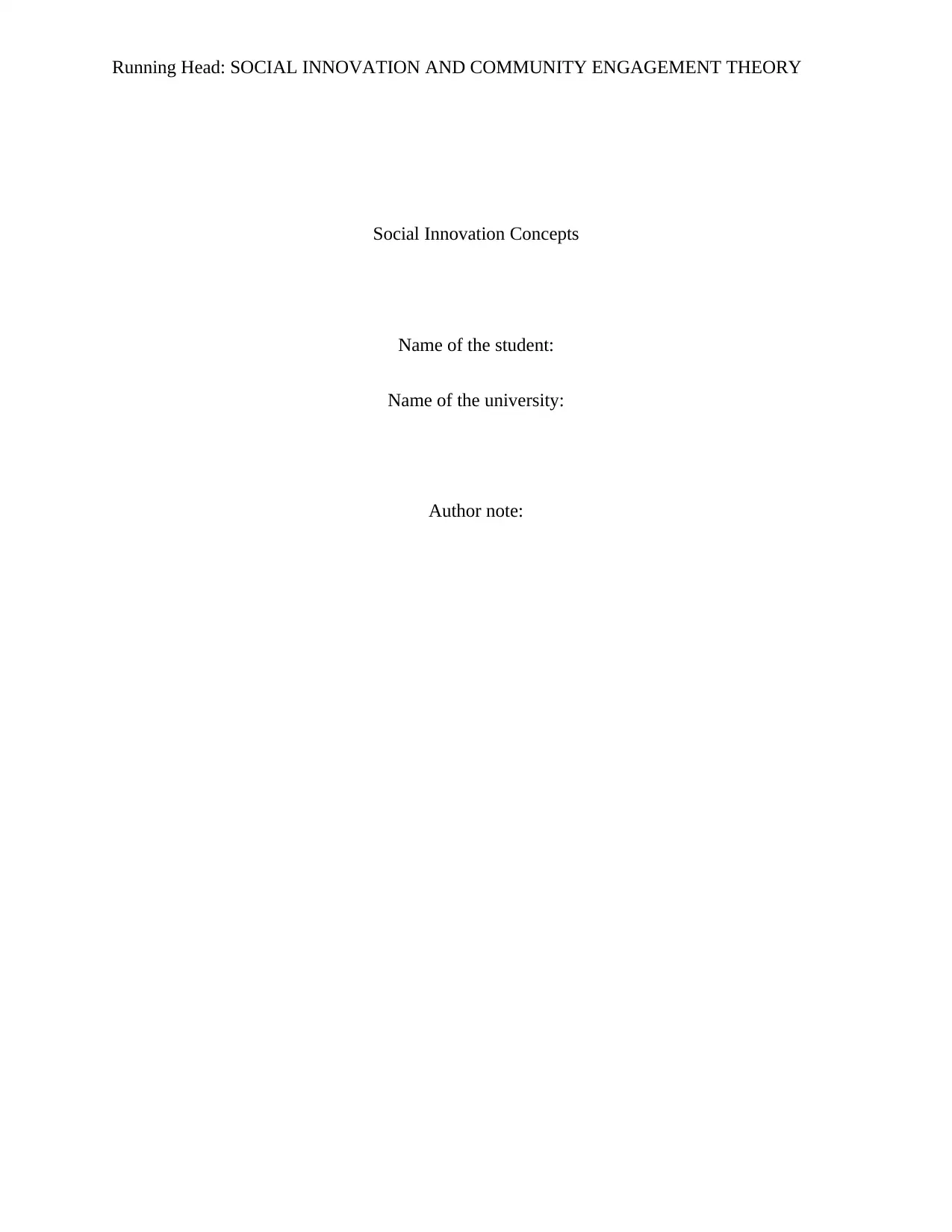
Running Head: SOCIAL INNOVATION AND COMMUNITY ENGAGEMENT THEORY
Social Innovation Concepts
Name of the student:
Name of the university:
Author note:
Social Innovation Concepts
Name of the student:
Name of the university:
Author note:
Secure Best Marks with AI Grader
Need help grading? Try our AI Grader for instant feedback on your assignments.
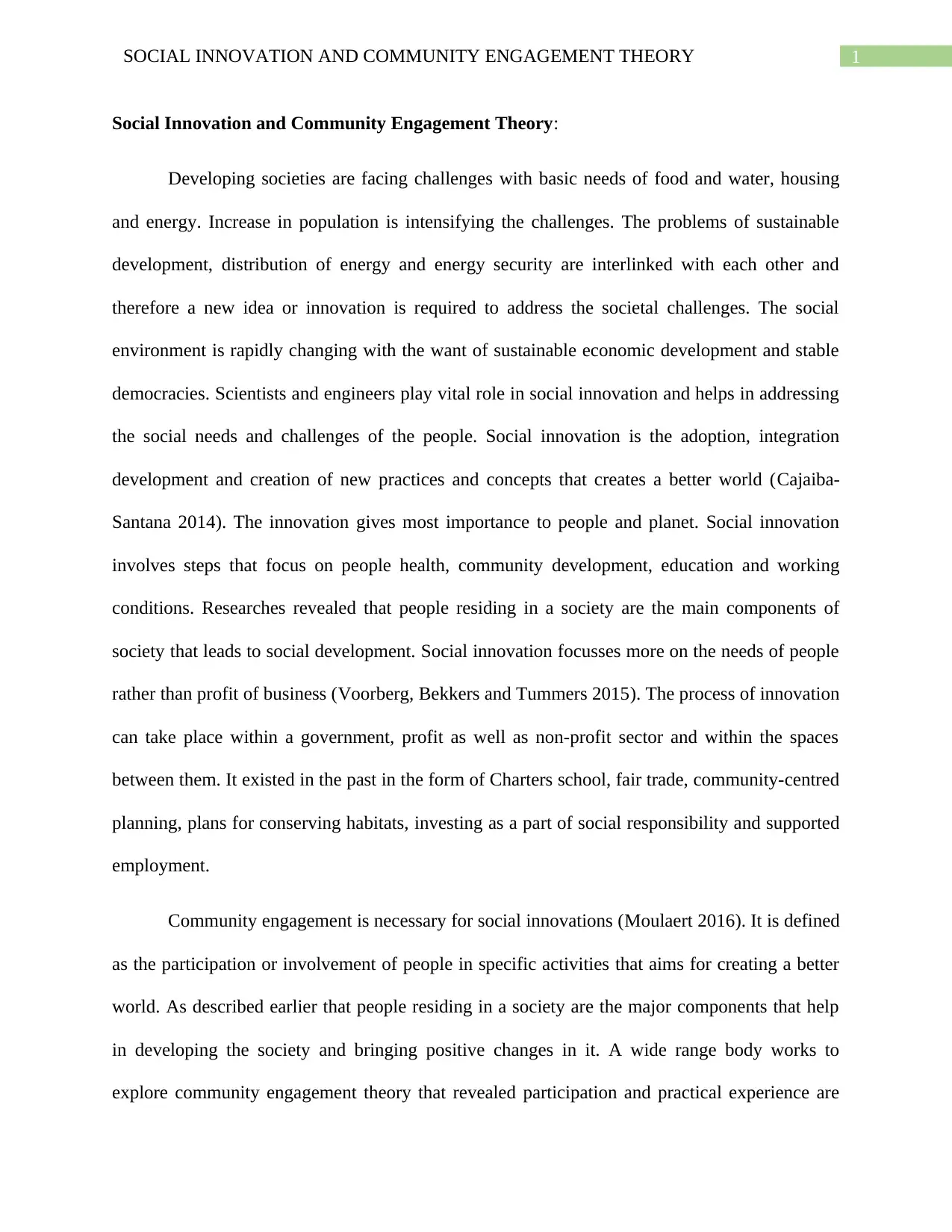
1SOCIAL INNOVATION AND COMMUNITY ENGAGEMENT THEORY
Social Innovation and Community Engagement Theory:
Developing societies are facing challenges with basic needs of food and water, housing
and energy. Increase in population is intensifying the challenges. The problems of sustainable
development, distribution of energy and energy security are interlinked with each other and
therefore a new idea or innovation is required to address the societal challenges. The social
environment is rapidly changing with the want of sustainable economic development and stable
democracies. Scientists and engineers play vital role in social innovation and helps in addressing
the social needs and challenges of the people. Social innovation is the adoption, integration
development and creation of new practices and concepts that creates a better world (Cajaiba-
Santana 2014). The innovation gives most importance to people and planet. Social innovation
involves steps that focus on people health, community development, education and working
conditions. Researches revealed that people residing in a society are the main components of
society that leads to social development. Social innovation focusses more on the needs of people
rather than profit of business (Voorberg, Bekkers and Tummers 2015). The process of innovation
can take place within a government, profit as well as non-profit sector and within the spaces
between them. It existed in the past in the form of Charters school, fair trade, community-centred
planning, plans for conserving habitats, investing as a part of social responsibility and supported
employment.
Community engagement is necessary for social innovations (Moulaert 2016). It is defined
as the participation or involvement of people in specific activities that aims for creating a better
world. As described earlier that people residing in a society are the major components that help
in developing the society and bringing positive changes in it. A wide range body works to
explore community engagement theory that revealed participation and practical experience are
Social Innovation and Community Engagement Theory:
Developing societies are facing challenges with basic needs of food and water, housing
and energy. Increase in population is intensifying the challenges. The problems of sustainable
development, distribution of energy and energy security are interlinked with each other and
therefore a new idea or innovation is required to address the societal challenges. The social
environment is rapidly changing with the want of sustainable economic development and stable
democracies. Scientists and engineers play vital role in social innovation and helps in addressing
the social needs and challenges of the people. Social innovation is the adoption, integration
development and creation of new practices and concepts that creates a better world (Cajaiba-
Santana 2014). The innovation gives most importance to people and planet. Social innovation
involves steps that focus on people health, community development, education and working
conditions. Researches revealed that people residing in a society are the main components of
society that leads to social development. Social innovation focusses more on the needs of people
rather than profit of business (Voorberg, Bekkers and Tummers 2015). The process of innovation
can take place within a government, profit as well as non-profit sector and within the spaces
between them. It existed in the past in the form of Charters school, fair trade, community-centred
planning, plans for conserving habitats, investing as a part of social responsibility and supported
employment.
Community engagement is necessary for social innovations (Moulaert 2016). It is defined
as the participation or involvement of people in specific activities that aims for creating a better
world. As described earlier that people residing in a society are the major components that help
in developing the society and bringing positive changes in it. A wide range body works to
explore community engagement theory that revealed participation and practical experience are
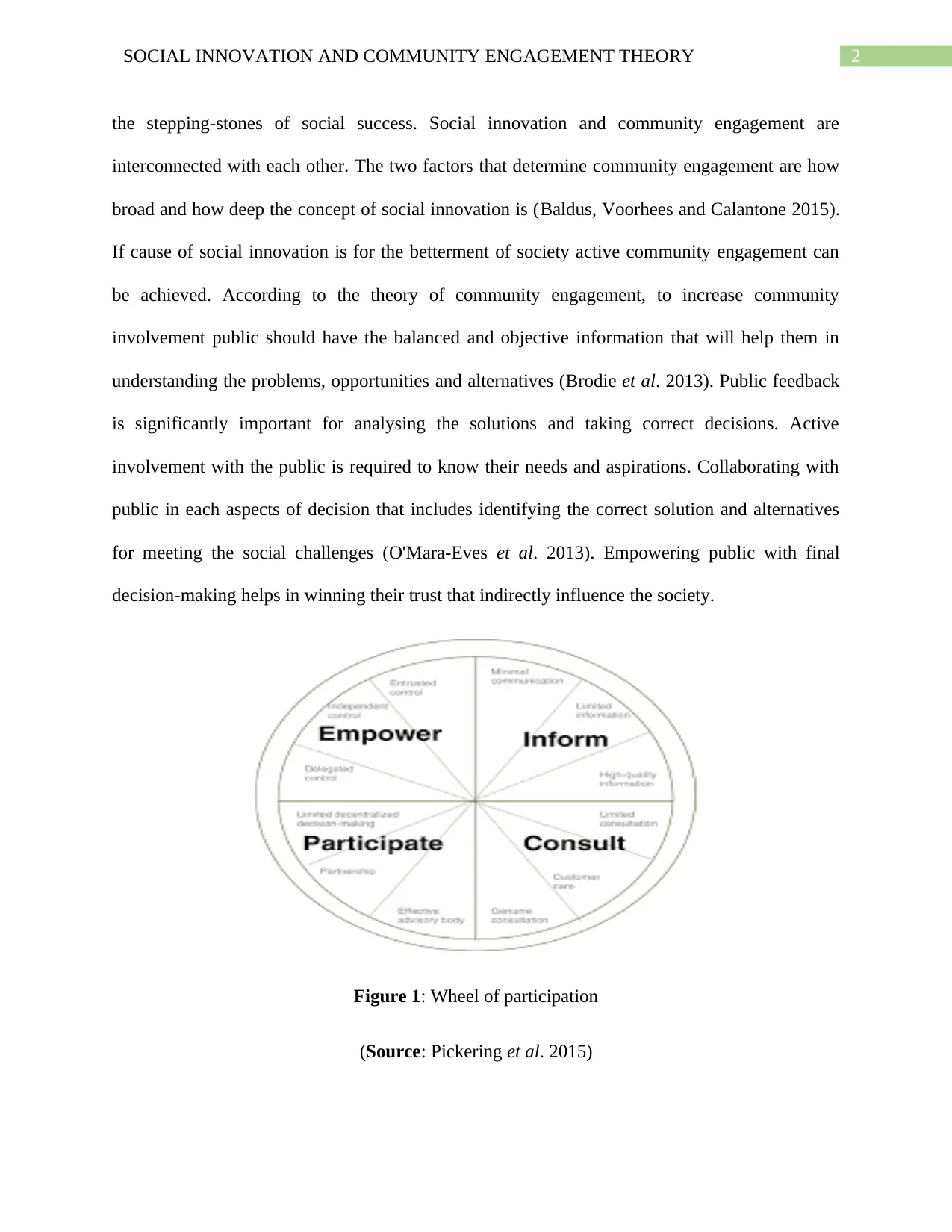
2SOCIAL INNOVATION AND COMMUNITY ENGAGEMENT THEORY
the stepping-stones of social success. Social innovation and community engagement are
interconnected with each other. The two factors that determine community engagement are how
broad and how deep the concept of social innovation is (Baldus, Voorhees and Calantone 2015).
If cause of social innovation is for the betterment of society active community engagement can
be achieved. According to the theory of community engagement, to increase community
involvement public should have the balanced and objective information that will help them in
understanding the problems, opportunities and alternatives (Brodie et al. 2013). Public feedback
is significantly important for analysing the solutions and taking correct decisions. Active
involvement with the public is required to know their needs and aspirations. Collaborating with
public in each aspects of decision that includes identifying the correct solution and alternatives
for meeting the social challenges (O'Mara-Eves et al. 2013). Empowering public with final
decision-making helps in winning their trust that indirectly influence the society.
Figure 1: Wheel of participation
(Source: Pickering et al. 2015)
the stepping-stones of social success. Social innovation and community engagement are
interconnected with each other. The two factors that determine community engagement are how
broad and how deep the concept of social innovation is (Baldus, Voorhees and Calantone 2015).
If cause of social innovation is for the betterment of society active community engagement can
be achieved. According to the theory of community engagement, to increase community
involvement public should have the balanced and objective information that will help them in
understanding the problems, opportunities and alternatives (Brodie et al. 2013). Public feedback
is significantly important for analysing the solutions and taking correct decisions. Active
involvement with the public is required to know their needs and aspirations. Collaborating with
public in each aspects of decision that includes identifying the correct solution and alternatives
for meeting the social challenges (O'Mara-Eves et al. 2013). Empowering public with final
decision-making helps in winning their trust that indirectly influence the society.
Figure 1: Wheel of participation
(Source: Pickering et al. 2015)
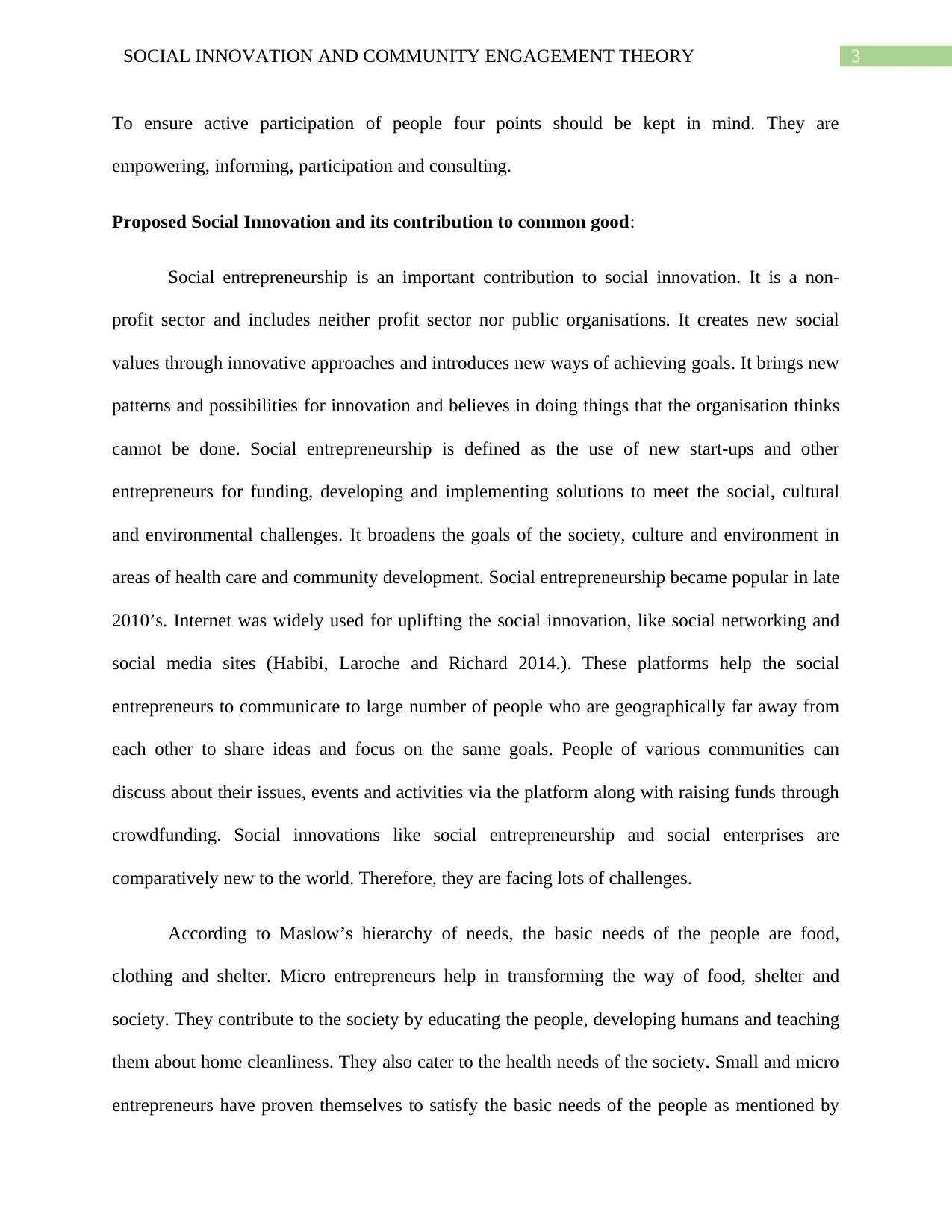
3SOCIAL INNOVATION AND COMMUNITY ENGAGEMENT THEORY
To ensure active participation of people four points should be kept in mind. They are
empowering, informing, participation and consulting.
Proposed Social Innovation and its contribution to common good:
Social entrepreneurship is an important contribution to social innovation. It is a non-
profit sector and includes neither profit sector nor public organisations. It creates new social
values through innovative approaches and introduces new ways of achieving goals. It brings new
patterns and possibilities for innovation and believes in doing things that the organisation thinks
cannot be done. Social entrepreneurship is defined as the use of new start-ups and other
entrepreneurs for funding, developing and implementing solutions to meet the social, cultural
and environmental challenges. It broadens the goals of the society, culture and environment in
areas of health care and community development. Social entrepreneurship became popular in late
2010’s. Internet was widely used for uplifting the social innovation, like social networking and
social media sites (Habibi, Laroche and Richard 2014.). These platforms help the social
entrepreneurs to communicate to large number of people who are geographically far away from
each other to share ideas and focus on the same goals. People of various communities can
discuss about their issues, events and activities via the platform along with raising funds through
crowdfunding. Social innovations like social entrepreneurship and social enterprises are
comparatively new to the world. Therefore, they are facing lots of challenges.
According to Maslow’s hierarchy of needs, the basic needs of the people are food,
clothing and shelter. Micro entrepreneurs help in transforming the way of food, shelter and
society. They contribute to the society by educating the people, developing humans and teaching
them about home cleanliness. They also cater to the health needs of the society. Small and micro
entrepreneurs have proven themselves to satisfy the basic needs of the people as mentioned by
To ensure active participation of people four points should be kept in mind. They are
empowering, informing, participation and consulting.
Proposed Social Innovation and its contribution to common good:
Social entrepreneurship is an important contribution to social innovation. It is a non-
profit sector and includes neither profit sector nor public organisations. It creates new social
values through innovative approaches and introduces new ways of achieving goals. It brings new
patterns and possibilities for innovation and believes in doing things that the organisation thinks
cannot be done. Social entrepreneurship is defined as the use of new start-ups and other
entrepreneurs for funding, developing and implementing solutions to meet the social, cultural
and environmental challenges. It broadens the goals of the society, culture and environment in
areas of health care and community development. Social entrepreneurship became popular in late
2010’s. Internet was widely used for uplifting the social innovation, like social networking and
social media sites (Habibi, Laroche and Richard 2014.). These platforms help the social
entrepreneurs to communicate to large number of people who are geographically far away from
each other to share ideas and focus on the same goals. People of various communities can
discuss about their issues, events and activities via the platform along with raising funds through
crowdfunding. Social innovations like social entrepreneurship and social enterprises are
comparatively new to the world. Therefore, they are facing lots of challenges.
According to Maslow’s hierarchy of needs, the basic needs of the people are food,
clothing and shelter. Micro entrepreneurs help in transforming the way of food, shelter and
society. They contribute to the society by educating the people, developing humans and teaching
them about home cleanliness. They also cater to the health needs of the society. Small and micro
entrepreneurs have proven themselves to satisfy the basic needs of the people as mentioned by
Secure Best Marks with AI Grader
Need help grading? Try our AI Grader for instant feedback on your assignments.
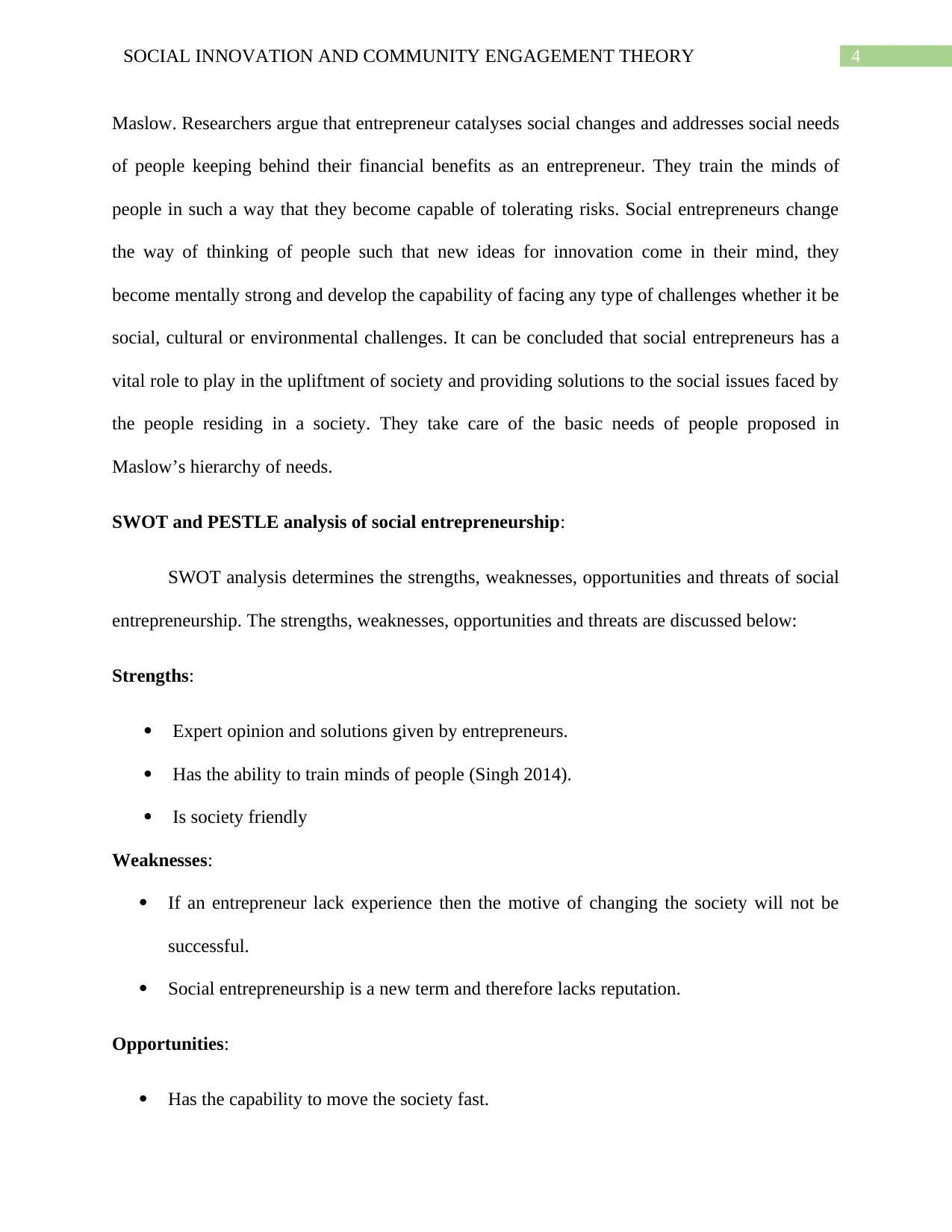
4SOCIAL INNOVATION AND COMMUNITY ENGAGEMENT THEORY
Maslow. Researchers argue that entrepreneur catalyses social changes and addresses social needs
of people keeping behind their financial benefits as an entrepreneur. They train the minds of
people in such a way that they become capable of tolerating risks. Social entrepreneurs change
the way of thinking of people such that new ideas for innovation come in their mind, they
become mentally strong and develop the capability of facing any type of challenges whether it be
social, cultural or environmental challenges. It can be concluded that social entrepreneurs has a
vital role to play in the upliftment of society and providing solutions to the social issues faced by
the people residing in a society. They take care of the basic needs of people proposed in
Maslow’s hierarchy of needs.
SWOT and PESTLE analysis of social entrepreneurship:
SWOT analysis determines the strengths, weaknesses, opportunities and threats of social
entrepreneurship. The strengths, weaknesses, opportunities and threats are discussed below:
Strengths:
Expert opinion and solutions given by entrepreneurs.
Has the ability to train minds of people (Singh 2014).
Is society friendly
Weaknesses:
If an entrepreneur lack experience then the motive of changing the society will not be
successful.
Social entrepreneurship is a new term and therefore lacks reputation.
Opportunities:
Has the capability to move the society fast.
Maslow. Researchers argue that entrepreneur catalyses social changes and addresses social needs
of people keeping behind their financial benefits as an entrepreneur. They train the minds of
people in such a way that they become capable of tolerating risks. Social entrepreneurs change
the way of thinking of people such that new ideas for innovation come in their mind, they
become mentally strong and develop the capability of facing any type of challenges whether it be
social, cultural or environmental challenges. It can be concluded that social entrepreneurs has a
vital role to play in the upliftment of society and providing solutions to the social issues faced by
the people residing in a society. They take care of the basic needs of people proposed in
Maslow’s hierarchy of needs.
SWOT and PESTLE analysis of social entrepreneurship:
SWOT analysis determines the strengths, weaknesses, opportunities and threats of social
entrepreneurship. The strengths, weaknesses, opportunities and threats are discussed below:
Strengths:
Expert opinion and solutions given by entrepreneurs.
Has the ability to train minds of people (Singh 2014).
Is society friendly
Weaknesses:
If an entrepreneur lack experience then the motive of changing the society will not be
successful.
Social entrepreneurship is a new term and therefore lacks reputation.
Opportunities:
Has the capability to move the society fast.
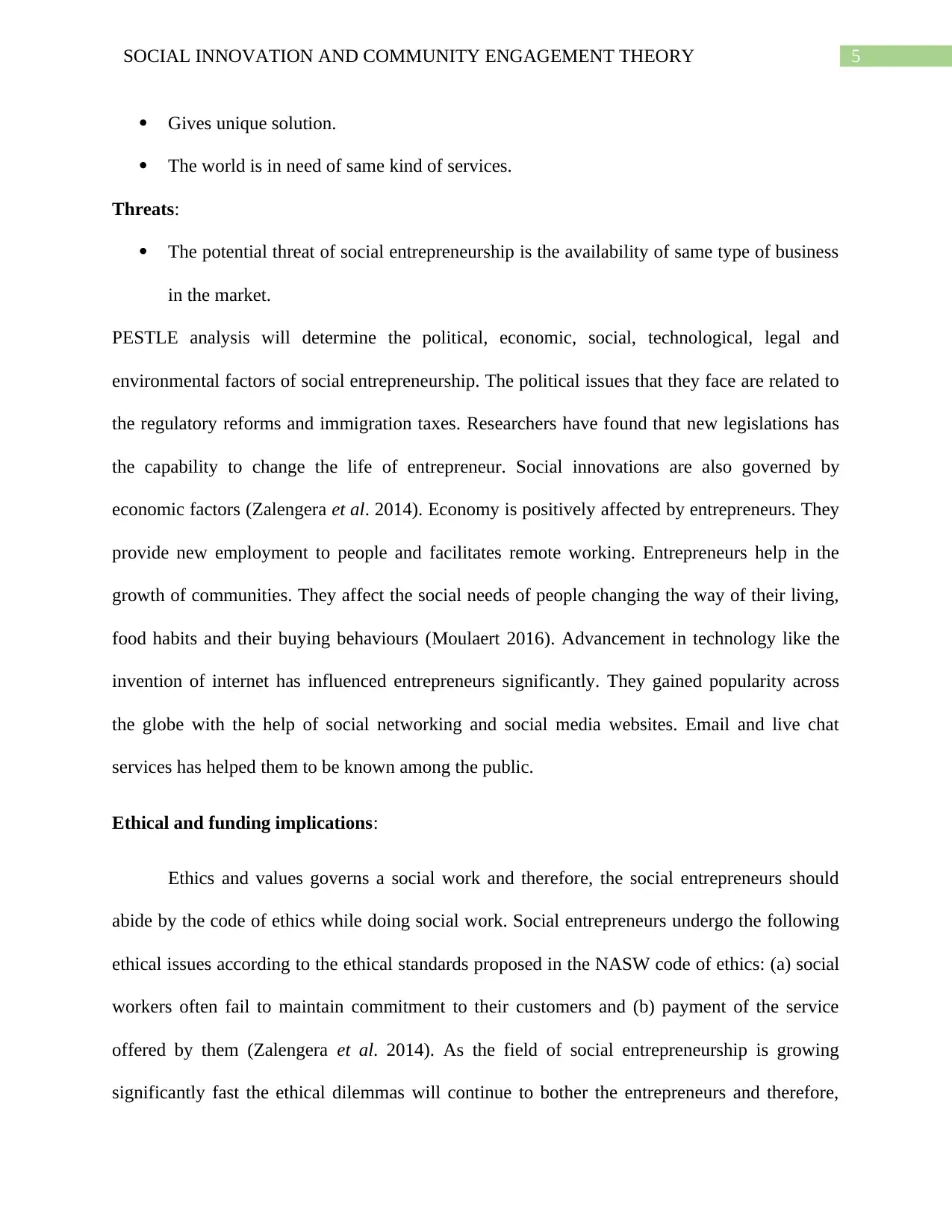
5SOCIAL INNOVATION AND COMMUNITY ENGAGEMENT THEORY
Gives unique solution.
The world is in need of same kind of services.
Threats:
The potential threat of social entrepreneurship is the availability of same type of business
in the market.
PESTLE analysis will determine the political, economic, social, technological, legal and
environmental factors of social entrepreneurship. The political issues that they face are related to
the regulatory reforms and immigration taxes. Researchers have found that new legislations has
the capability to change the life of entrepreneur. Social innovations are also governed by
economic factors (Zalengera et al. 2014). Economy is positively affected by entrepreneurs. They
provide new employment to people and facilitates remote working. Entrepreneurs help in the
growth of communities. They affect the social needs of people changing the way of their living,
food habits and their buying behaviours (Moulaert 2016). Advancement in technology like the
invention of internet has influenced entrepreneurs significantly. They gained popularity across
the globe with the help of social networking and social media websites. Email and live chat
services has helped them to be known among the public.
Ethical and funding implications:
Ethics and values governs a social work and therefore, the social entrepreneurs should
abide by the code of ethics while doing social work. Social entrepreneurs undergo the following
ethical issues according to the ethical standards proposed in the NASW code of ethics: (a) social
workers often fail to maintain commitment to their customers and (b) payment of the service
offered by them (Zalengera et al. 2014). As the field of social entrepreneurship is growing
significantly fast the ethical dilemmas will continue to bother the entrepreneurs and therefore,
Gives unique solution.
The world is in need of same kind of services.
Threats:
The potential threat of social entrepreneurship is the availability of same type of business
in the market.
PESTLE analysis will determine the political, economic, social, technological, legal and
environmental factors of social entrepreneurship. The political issues that they face are related to
the regulatory reforms and immigration taxes. Researchers have found that new legislations has
the capability to change the life of entrepreneur. Social innovations are also governed by
economic factors (Zalengera et al. 2014). Economy is positively affected by entrepreneurs. They
provide new employment to people and facilitates remote working. Entrepreneurs help in the
growth of communities. They affect the social needs of people changing the way of their living,
food habits and their buying behaviours (Moulaert 2016). Advancement in technology like the
invention of internet has influenced entrepreneurs significantly. They gained popularity across
the globe with the help of social networking and social media websites. Email and live chat
services has helped them to be known among the public.
Ethical and funding implications:
Ethics and values governs a social work and therefore, the social entrepreneurs should
abide by the code of ethics while doing social work. Social entrepreneurs undergo the following
ethical issues according to the ethical standards proposed in the NASW code of ethics: (a) social
workers often fail to maintain commitment to their customers and (b) payment of the service
offered by them (Zalengera et al. 2014). As the field of social entrepreneurship is growing
significantly fast the ethical dilemmas will continue to bother the entrepreneurs and therefore,
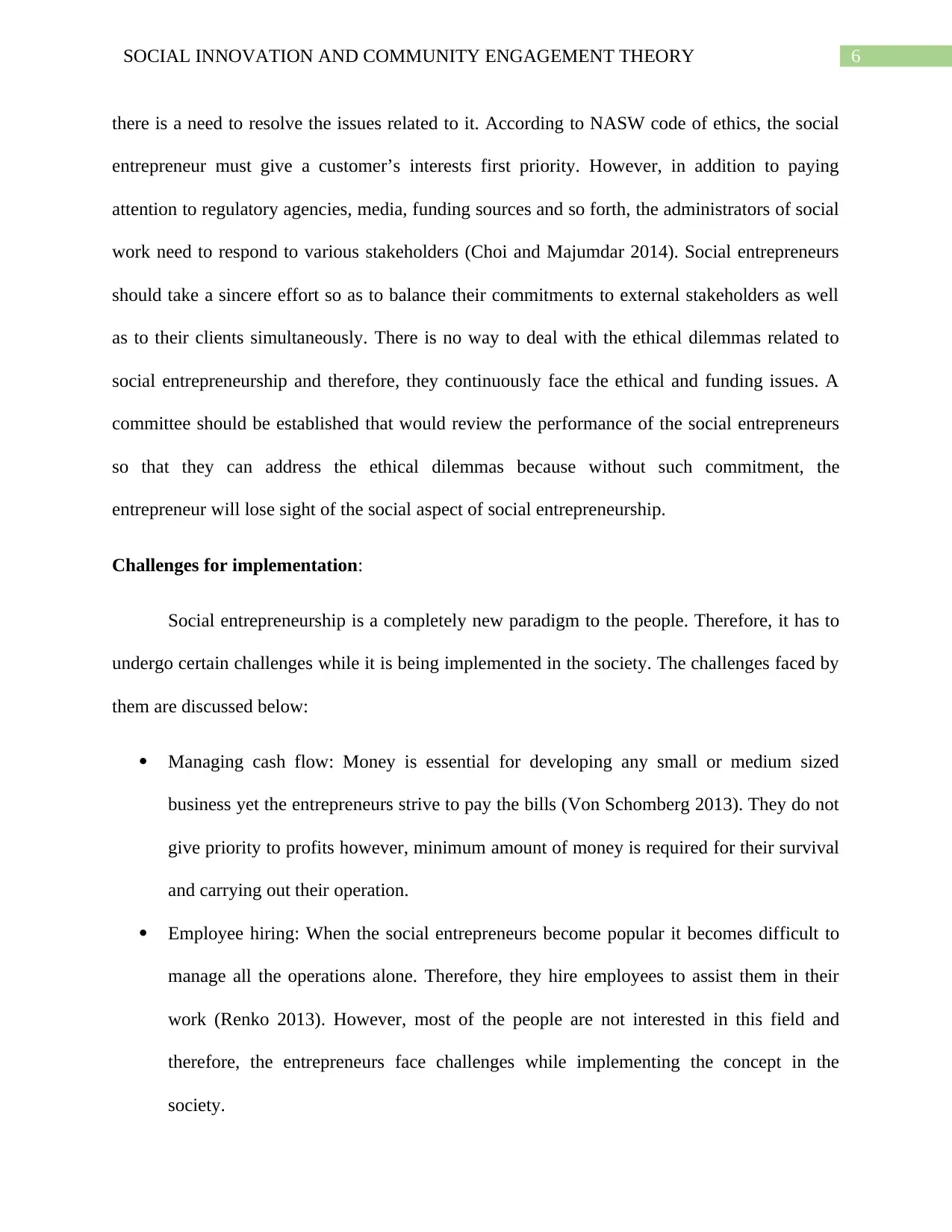
6SOCIAL INNOVATION AND COMMUNITY ENGAGEMENT THEORY
there is a need to resolve the issues related to it. According to NASW code of ethics, the social
entrepreneur must give a customer’s interests first priority. However, in addition to paying
attention to regulatory agencies, media, funding sources and so forth, the administrators of social
work need to respond to various stakeholders (Choi and Majumdar 2014). Social entrepreneurs
should take a sincere effort so as to balance their commitments to external stakeholders as well
as to their clients simultaneously. There is no way to deal with the ethical dilemmas related to
social entrepreneurship and therefore, they continuously face the ethical and funding issues. A
committee should be established that would review the performance of the social entrepreneurs
so that they can address the ethical dilemmas because without such commitment, the
entrepreneur will lose sight of the social aspect of social entrepreneurship.
Challenges for implementation:
Social entrepreneurship is a completely new paradigm to the people. Therefore, it has to
undergo certain challenges while it is being implemented in the society. The challenges faced by
them are discussed below:
Managing cash flow: Money is essential for developing any small or medium sized
business yet the entrepreneurs strive to pay the bills (Von Schomberg 2013). They do not
give priority to profits however, minimum amount of money is required for their survival
and carrying out their operation.
Employee hiring: When the social entrepreneurs become popular it becomes difficult to
manage all the operations alone. Therefore, they hire employees to assist them in their
work (Renko 2013). However, most of the people are not interested in this field and
therefore, the entrepreneurs face challenges while implementing the concept in the
society.
there is a need to resolve the issues related to it. According to NASW code of ethics, the social
entrepreneur must give a customer’s interests first priority. However, in addition to paying
attention to regulatory agencies, media, funding sources and so forth, the administrators of social
work need to respond to various stakeholders (Choi and Majumdar 2014). Social entrepreneurs
should take a sincere effort so as to balance their commitments to external stakeholders as well
as to their clients simultaneously. There is no way to deal with the ethical dilemmas related to
social entrepreneurship and therefore, they continuously face the ethical and funding issues. A
committee should be established that would review the performance of the social entrepreneurs
so that they can address the ethical dilemmas because without such commitment, the
entrepreneur will lose sight of the social aspect of social entrepreneurship.
Challenges for implementation:
Social entrepreneurship is a completely new paradigm to the people. Therefore, it has to
undergo certain challenges while it is being implemented in the society. The challenges faced by
them are discussed below:
Managing cash flow: Money is essential for developing any small or medium sized
business yet the entrepreneurs strive to pay the bills (Von Schomberg 2013). They do not
give priority to profits however, minimum amount of money is required for their survival
and carrying out their operation.
Employee hiring: When the social entrepreneurs become popular it becomes difficult to
manage all the operations alone. Therefore, they hire employees to assist them in their
work (Renko 2013). However, most of the people are not interested in this field and
therefore, the entrepreneurs face challenges while implementing the concept in the
society.
Paraphrase This Document
Need a fresh take? Get an instant paraphrase of this document with our AI Paraphraser
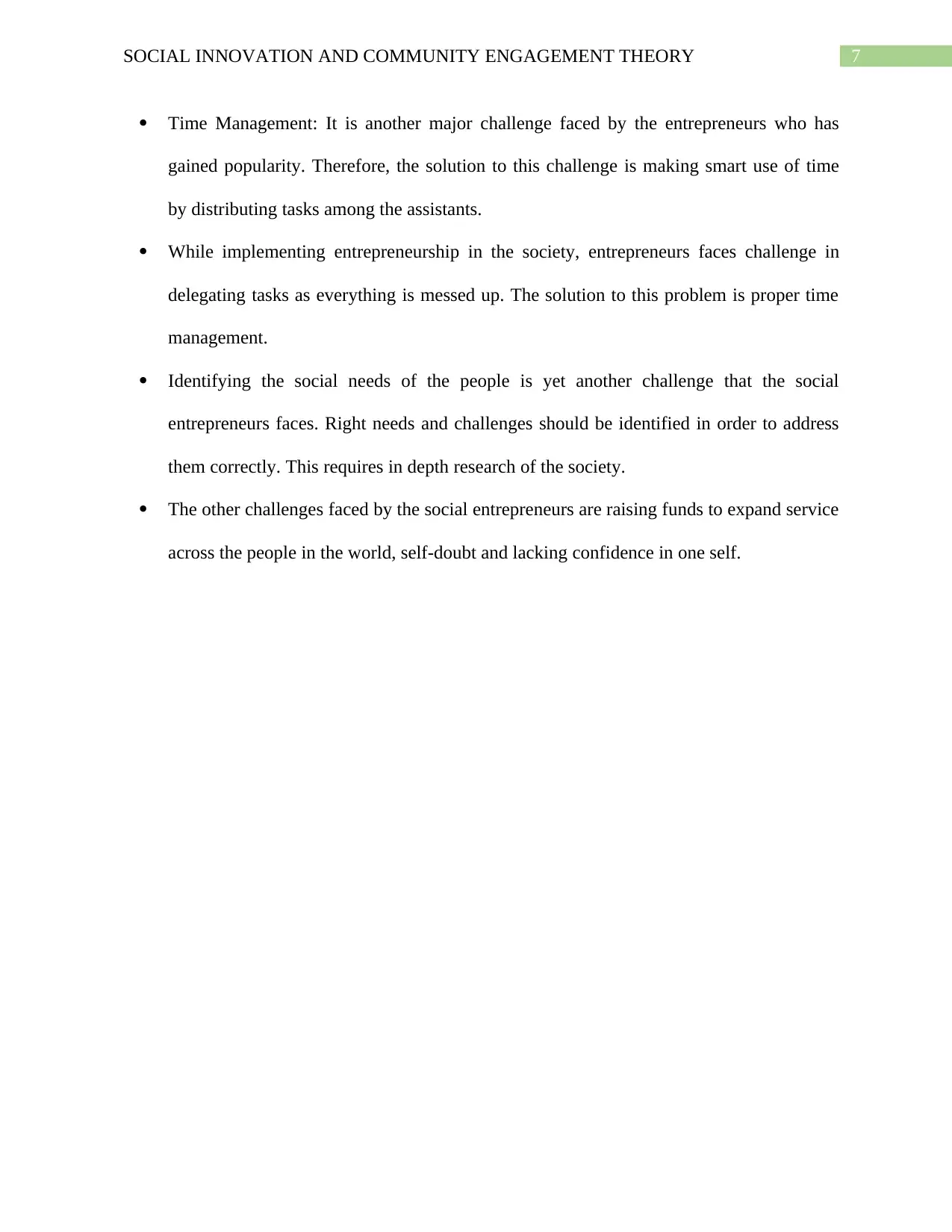
7SOCIAL INNOVATION AND COMMUNITY ENGAGEMENT THEORY
Time Management: It is another major challenge faced by the entrepreneurs who has
gained popularity. Therefore, the solution to this challenge is making smart use of time
by distributing tasks among the assistants.
While implementing entrepreneurship in the society, entrepreneurs faces challenge in
delegating tasks as everything is messed up. The solution to this problem is proper time
management.
Identifying the social needs of the people is yet another challenge that the social
entrepreneurs faces. Right needs and challenges should be identified in order to address
them correctly. This requires in depth research of the society.
The other challenges faced by the social entrepreneurs are raising funds to expand service
across the people in the world, self-doubt and lacking confidence in one self.
Time Management: It is another major challenge faced by the entrepreneurs who has
gained popularity. Therefore, the solution to this challenge is making smart use of time
by distributing tasks among the assistants.
While implementing entrepreneurship in the society, entrepreneurs faces challenge in
delegating tasks as everything is messed up. The solution to this problem is proper time
management.
Identifying the social needs of the people is yet another challenge that the social
entrepreneurs faces. Right needs and challenges should be identified in order to address
them correctly. This requires in depth research of the society.
The other challenges faced by the social entrepreneurs are raising funds to expand service
across the people in the world, self-doubt and lacking confidence in one self.
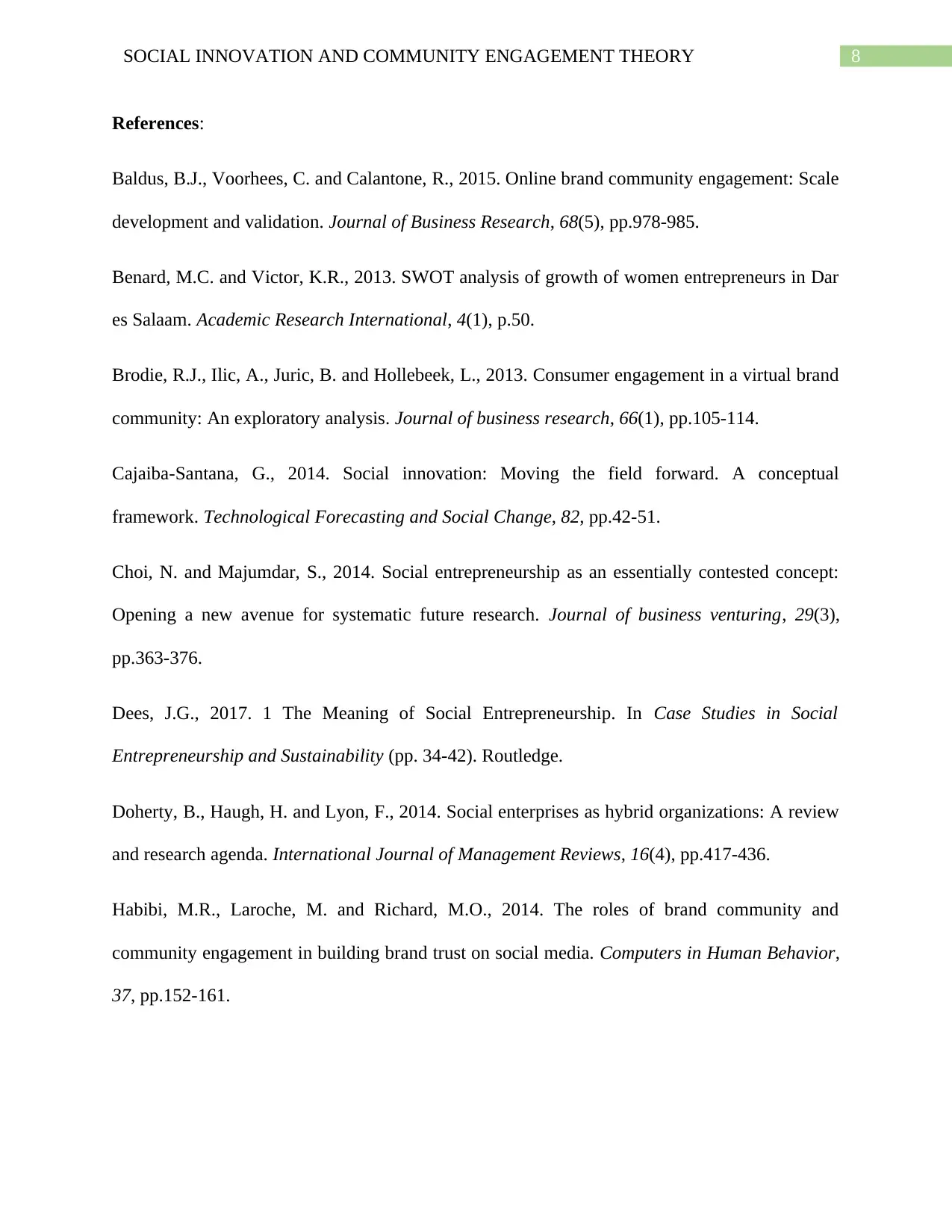
8SOCIAL INNOVATION AND COMMUNITY ENGAGEMENT THEORY
References:
Baldus, B.J., Voorhees, C. and Calantone, R., 2015. Online brand community engagement: Scale
development and validation. Journal of Business Research, 68(5), pp.978-985.
Benard, M.C. and Victor, K.R., 2013. SWOT analysis of growth of women entrepreneurs in Dar
es Salaam. Academic Research International, 4(1), p.50.
Brodie, R.J., Ilic, A., Juric, B. and Hollebeek, L., 2013. Consumer engagement in a virtual brand
community: An exploratory analysis. Journal of business research, 66(1), pp.105-114.
Cajaiba-Santana, G., 2014. Social innovation: Moving the field forward. A conceptual
framework. Technological Forecasting and Social Change, 82, pp.42-51.
Choi, N. and Majumdar, S., 2014. Social entrepreneurship as an essentially contested concept:
Opening a new avenue for systematic future research. Journal of business venturing, 29(3),
pp.363-376.
Dees, J.G., 2017. 1 The Meaning of Social Entrepreneurship. In Case Studies in Social
Entrepreneurship and Sustainability (pp. 34-42). Routledge.
Doherty, B., Haugh, H. and Lyon, F., 2014. Social enterprises as hybrid organizations: A review
and research agenda. International Journal of Management Reviews, 16(4), pp.417-436.
Habibi, M.R., Laroche, M. and Richard, M.O., 2014. The roles of brand community and
community engagement in building brand trust on social media. Computers in Human Behavior,
37, pp.152-161.
References:
Baldus, B.J., Voorhees, C. and Calantone, R., 2015. Online brand community engagement: Scale
development and validation. Journal of Business Research, 68(5), pp.978-985.
Benard, M.C. and Victor, K.R., 2013. SWOT analysis of growth of women entrepreneurs in Dar
es Salaam. Academic Research International, 4(1), p.50.
Brodie, R.J., Ilic, A., Juric, B. and Hollebeek, L., 2013. Consumer engagement in a virtual brand
community: An exploratory analysis. Journal of business research, 66(1), pp.105-114.
Cajaiba-Santana, G., 2014. Social innovation: Moving the field forward. A conceptual
framework. Technological Forecasting and Social Change, 82, pp.42-51.
Choi, N. and Majumdar, S., 2014. Social entrepreneurship as an essentially contested concept:
Opening a new avenue for systematic future research. Journal of business venturing, 29(3),
pp.363-376.
Dees, J.G., 2017. 1 The Meaning of Social Entrepreneurship. In Case Studies in Social
Entrepreneurship and Sustainability (pp. 34-42). Routledge.
Doherty, B., Haugh, H. and Lyon, F., 2014. Social enterprises as hybrid organizations: A review
and research agenda. International Journal of Management Reviews, 16(4), pp.417-436.
Habibi, M.R., Laroche, M. and Richard, M.O., 2014. The roles of brand community and
community engagement in building brand trust on social media. Computers in Human Behavior,
37, pp.152-161.
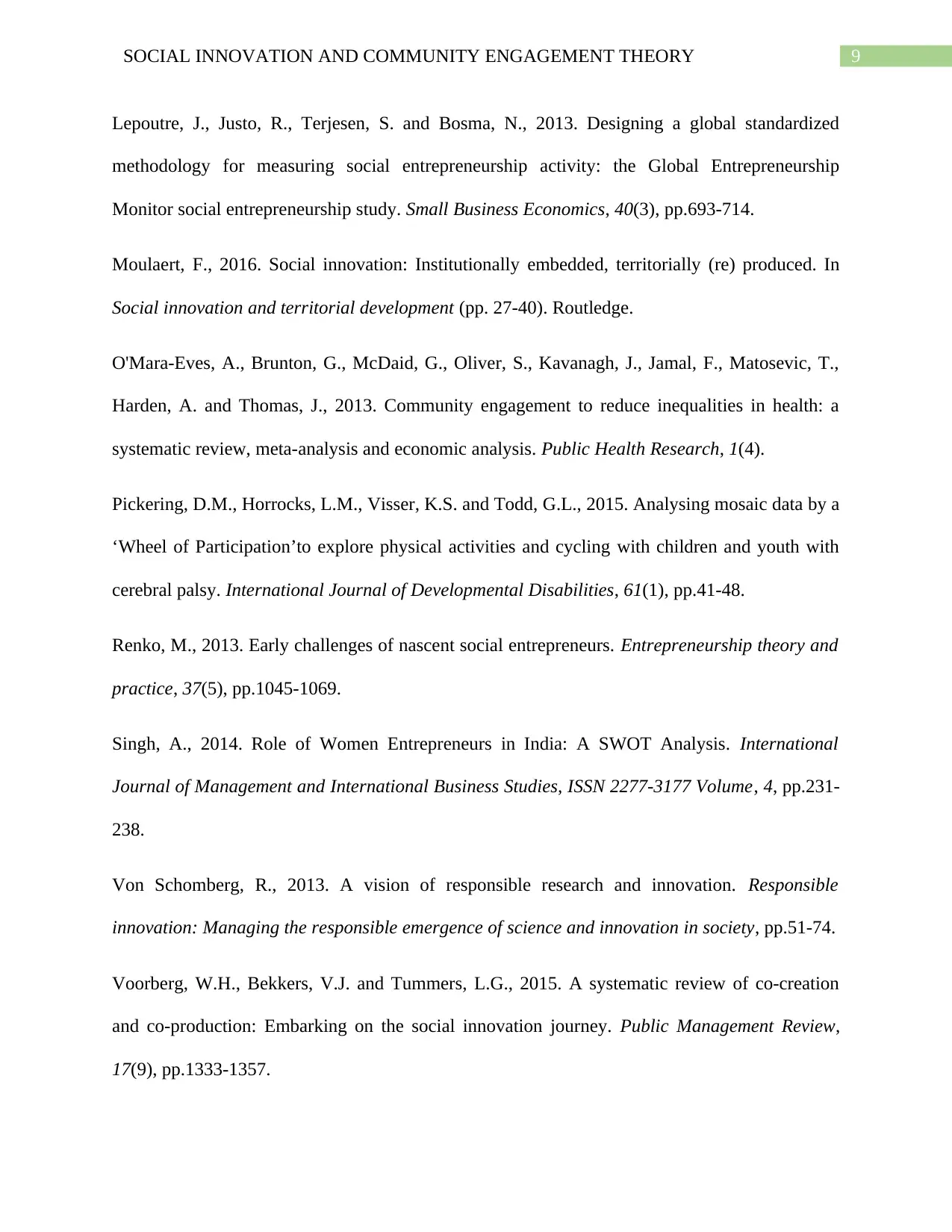
9SOCIAL INNOVATION AND COMMUNITY ENGAGEMENT THEORY
Lepoutre, J., Justo, R., Terjesen, S. and Bosma, N., 2013. Designing a global standardized
methodology for measuring social entrepreneurship activity: the Global Entrepreneurship
Monitor social entrepreneurship study. Small Business Economics, 40(3), pp.693-714.
Moulaert, F., 2016. Social innovation: Institutionally embedded, territorially (re) produced. In
Social innovation and territorial development (pp. 27-40). Routledge.
O'Mara-Eves, A., Brunton, G., McDaid, G., Oliver, S., Kavanagh, J., Jamal, F., Matosevic, T.,
Harden, A. and Thomas, J., 2013. Community engagement to reduce inequalities in health: a
systematic review, meta-analysis and economic analysis. Public Health Research, 1(4).
Pickering, D.M., Horrocks, L.M., Visser, K.S. and Todd, G.L., 2015. Analysing mosaic data by a
‘Wheel of Participation’to explore physical activities and cycling with children and youth with
cerebral palsy. International Journal of Developmental Disabilities, 61(1), pp.41-48.
Renko, M., 2013. Early challenges of nascent social entrepreneurs. Entrepreneurship theory and
practice, 37(5), pp.1045-1069.
Singh, A., 2014. Role of Women Entrepreneurs in India: A SWOT Analysis. International
Journal of Management and International Business Studies, ISSN 2277-3177 Volume, 4, pp.231-
238.
Von Schomberg, R., 2013. A vision of responsible research and innovation. Responsible
innovation: Managing the responsible emergence of science and innovation in society, pp.51-74.
Voorberg, W.H., Bekkers, V.J. and Tummers, L.G., 2015. A systematic review of co-creation
and co-production: Embarking on the social innovation journey. Public Management Review,
17(9), pp.1333-1357.
Lepoutre, J., Justo, R., Terjesen, S. and Bosma, N., 2013. Designing a global standardized
methodology for measuring social entrepreneurship activity: the Global Entrepreneurship
Monitor social entrepreneurship study. Small Business Economics, 40(3), pp.693-714.
Moulaert, F., 2016. Social innovation: Institutionally embedded, territorially (re) produced. In
Social innovation and territorial development (pp. 27-40). Routledge.
O'Mara-Eves, A., Brunton, G., McDaid, G., Oliver, S., Kavanagh, J., Jamal, F., Matosevic, T.,
Harden, A. and Thomas, J., 2013. Community engagement to reduce inequalities in health: a
systematic review, meta-analysis and economic analysis. Public Health Research, 1(4).
Pickering, D.M., Horrocks, L.M., Visser, K.S. and Todd, G.L., 2015. Analysing mosaic data by a
‘Wheel of Participation’to explore physical activities and cycling with children and youth with
cerebral palsy. International Journal of Developmental Disabilities, 61(1), pp.41-48.
Renko, M., 2013. Early challenges of nascent social entrepreneurs. Entrepreneurship theory and
practice, 37(5), pp.1045-1069.
Singh, A., 2014. Role of Women Entrepreneurs in India: A SWOT Analysis. International
Journal of Management and International Business Studies, ISSN 2277-3177 Volume, 4, pp.231-
238.
Von Schomberg, R., 2013. A vision of responsible research and innovation. Responsible
innovation: Managing the responsible emergence of science and innovation in society, pp.51-74.
Voorberg, W.H., Bekkers, V.J. and Tummers, L.G., 2015. A systematic review of co-creation
and co-production: Embarking on the social innovation journey. Public Management Review,
17(9), pp.1333-1357.
Secure Best Marks with AI Grader
Need help grading? Try our AI Grader for instant feedback on your assignments.

10SOCIAL INNOVATION AND COMMUNITY ENGAGEMENT THEORY
Zalengera, C., Blanchard, R.E., Eames, P.C., Juma, A.M., Chitawo, M.L. and Gondwe, K.T.,
2014. Overview of the Malawi energy situation and A PESTLE analysis for sustainable
development of renewable energy. Renewable and Sustainable Energy Reviews, 38, pp.335-347.
Zalengera, C., Blanchard, R.E., Eames, P.C., Juma, A.M., Chitawo, M.L. and Gondwe, K.T.,
2014. Overview of the Malawi energy situation and A PESTLE analysis for sustainable
development of renewable energy. Renewable and Sustainable Energy Reviews, 38, pp.335-347.
1 out of 11
Related Documents
Your All-in-One AI-Powered Toolkit for Academic Success.
+13062052269
info@desklib.com
Available 24*7 on WhatsApp / Email
![[object Object]](/_next/static/media/star-bottom.7253800d.svg)
Unlock your academic potential
© 2024 | Zucol Services PVT LTD | All rights reserved.




